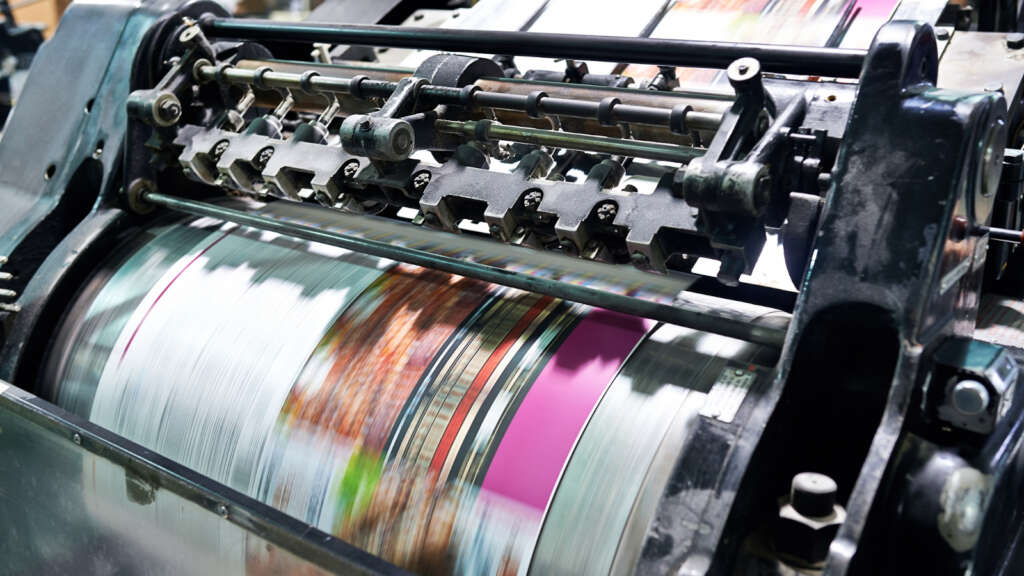Offset Printing
Printing with an offset press is one of the printing methods that is used the most frequently all over the world. It is a printing process that produces high-quality prints by moving ink from a plate to a rubber blanket, which subsequently rolls the ink onto paper or other surfaces. The process is known as gravure printing. The ink is not applied directly to the paper; rather, it is offset onto another surface before being applied to the paper. This is why the process is referred to as “offset.”

This method is utilized in the printing of substantial quantities of high-quality, full-color documents, including but not limited to books, brochures, magazines, newspapers, and materials for packaging. Additionally, it is utilized in the printing of stationery products such as business cards, letterheads, and other items. In this piece, we will go over the history of offset printing, the process that is involved in offset printing, as well as the benefits and drawbacks of employing this method.
The Origins and Development of Offset Printing
The printing method known as offset printing may be traced back to Alois Senefelder’s invention of lithography, which took place in the late 1700s. In the printing process known as lithography, an inked image is transferred from a flat stone or metal plate onto paper. Offset lithography was developed in the early 1900s and it included moving ink from the printing plate to a rubber blanket, which was subsequently transferred onto the paper. This process was known as “offset.”
In 1907, an American company called Harris-Seybold was responsible for the introduction of the first commercial offset press. This press had the capacity to print up to 10,000 sheets per hour, and it brought about a revolution in the printing business by making it feasible to print enormous quantities of papers of high quality in a quick and effective manner.
The technology of offset printing continued to advance in the decades that followed, with advancements made to the quality of the plates, the inks, and the presses themselves. Offset printing is currently the preeminent printing method utilized for commercial printing, with more than fifty percent of the market share across the globe.
The Process of Printing Using Offset
There are a few stages involved in the offset printing process, including the prepress, printing, and finishing stages.
Prepress
Getting the artwork ready for printing is one of the tasks involved in the prepress step. In this step, you will design the layout of the document, choose the colors that will be used, and create the printing plates.
Desktop publishing software such as Adobe InDesign or QuarkXPress is frequently utilized in the creation process of artwork. When the artwork is finished, it is either captured on film or saved as a digital file, and then the film or digital file is utilized to generate the printing plates.
The printing plates are commonly constructed of aluminum or polyester, and the photolithographic technique is used to manufacture them. After having an emulsion that is sensitive to light applied to them, the plates are then exposed to ultraviolet light while being projected through a film negative of the artwork. The parts of the plate that are exposed to air harden, while the parts that are not exposed to air stay soft and are eroded away. The finished plate will have a raised image of the artwork on it, and this raised image will be utilized to transfer ink from the plate to the paper.
Printing
After the printing plates have been created, they are prepared for use on the printing press. In most cases, the press will have a number of cylinders, each of which will serve a distinct purpose. The ink is moved from the plate to the blanket cylinder using the “plate cylinder,” which is the first cylinder in the printing press. After that, the blanket cylinder will transfer the ink from the cylinder to the paper.
At a rapid pace, the paper is moved through the press, and individual plates for each color are then printed. To do this, a separate plate and cylinder are utilized for each color in the process. After the printing of each color has been completed, the paper is next trimmed and cut to the appropriate dimensions.
Finishing
After the printing process is complete, the document could go through some extra finishing steps, such as folding, binding, or laminating. These procedures change depending on the kind of document that is being created and the outcome that is intended.

